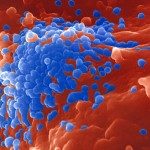Link to Pubmed [PMID] – 23199960
Vaccine 2012 Nov;30 Suppl 5:F168-74
The vast majority of women infected with human immunodeficiency virus (HIV) will be co-infected with human papillomavirus (HPV). The interaction between the two sexually transmitted infections appears to be related to the alteration in cell-mediated immunity in HIV infected persons, increased susceptibility, and possibly reactivation of latent HPV infection. Linkage studies of HIV/AIDs and Cancer registries have indicated a 2- to 22-fold increase in cervical cancer in HIV-positive women compared to HIV-negative women. Data on the prevalence of HPV types in invasive cervical carcinoma (ICC) suggest that the proportion of infection with types HPV16/18 (responsible for over 70% of all cervical cancers) is similar in HIV-negative and HIV-positive women. The biological interaction between HIV and HPV needs further elucidation, although there is some evidence that the presence of HPV infection may be associated with increased HIV transmission. Adolescents perinatally infected by HIV are known to have higher rates of HPV infection and also have been shown to seroconvert in response to HPV vaccination with the quadrivalent vaccine, albeit to lower titers than HIV-negative individuals. Anal cancer incidence is greatly increased in HIV-positive individuals, particularly in HIV-positive men who have sex with men. Screening for anal cancer precursors is feasible and effective; however, the impact on reduction of anal cancer remains to be demonstrated. There are ongoing studies on the safety, immunogenicity, and efficacy of current HPV vaccines in HIV-positive individuals and mature data are awaited. Male circumcision may be another approach to prevention of HPV transmission, which also requires further study. This article forms part of a special supplement entitled “Comprehensive Control of HPV Infections and Related Diseases” Vaccine Volume 30, Supplement 5, 2012.

